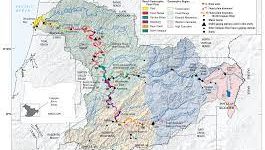Full Report here: E420_Assignment5_Report_SimonCampbell
Here, I take a look at the established framework for evaluating vegetation response to variability in precipitation, using catchment hydrologic data to quantify the relationships between different hydrologic parameters at the catchment scale. This gives us a way in which we can predict ecosystem responses to changes in the availability of water, especially the proportion made available as evapotranspiration – which is essentially a response to precipitation, runoff, and temperature which controls terrestrial productivity at varying scales. Horton Index (HI) is used to represent the ability of catchment vegetation to use plant available water, which is a key parameter for addressing ways in which hydrological partitioning can be telling of catchment runoff responses. The objective of this paper is to describe how patterns of hydrological partitioning are influencing catchment scale evapotranspiration (ET), described by changes in (HI).


Learning Significance